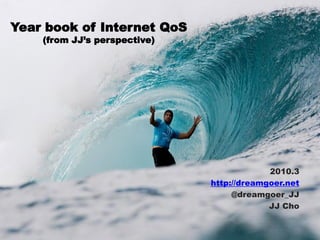
20100322 Internet QoS Year Book (Jj, 1992 To 2010)
- 1. Year book of Internet QoS (from JJ’s perspective) 2010.3 http://dreamgoer.net @dreamgoer_JJ JJ Cho
- 2. Before you move to next • I listed the changes happened in Internet from 1992 to today (2010) • This is totally my own view, so it could be wrong. • I tried to be neutral, but I admit I maybe somewhat biased due to my national background (Korea) • Images are taken from Internet without getting proper permission, some images may not be right for the content (don’t argue with this) • Still in progress, so pages may be updated without prior notice ※ Regarding the images included in the slides, I am not going to get any profit from this images. It is only to share. If there is anyone who offended by my use of them, please tell me. I will get rid of the image.
- 3. ~1992 (Text world) • Internet via telephony lines (Analog modem) • Text-based, bbs style internet use (~1990) • Internet only for Geeks – Telnet, SLIP, PPP, FTP, Gopher, SMTP, etc
- 4. 1993 – GUI Intro • Since Windows 3.0 release (1990), GUI prevails (Most BBS moves from dos to Windows environment) • People joins online – AOL becomes the most popular internet connection point – In Korea, Unitel, Hitel, Chollian Majic Eye, etc… • However, internet still belongs to Geeks (no QoS)
- 5. 1994 – HTML Internet appears • HTML appears • Stunned text-based Geeks • Mostly Hyper text, not hyper-media
- 6. 1995 – Commercial Internet Browsers • Netscape navigators (Originally 1994…) • MS recognizes the importance of Internet Internet Explorer • Internet becomes EASIER
- 7. 1996 – IPv6 appears • Internet becomes popular – Company, univ, and other organizations are asking for IP addresses – Mostly for email • People worry depletion of IP address IPv6 appear • Also, note that IPv6 addresses security, QoS issue
- 8. 1997 – Internet not for geeks any more • Easy search tools Yahoo (1996), Google (1997) • Major usage: Mail (AOL in US, Hanmail in Korea) • In Korea, thruNet offers the 1st cable-based broadband service • People, not geeks, joins Internet
- 9. 1998 – Telco’s Broadband prep • All the major telcos prepare for broadband Internet Connection Service • Backbone network direction : ATM vs. IP? – Cisco IP, Lucent, Alcatel ATM – growing concerns of QoS, due to multimedia data
- 10. 1999 – Broadband Internet ready • xDSL commerically serviced (In Korea, worldwide first) • Faster Internet “Wow, internet pages are like pages in the book!!!”
- 11. 2000 – P2P new paradaim • Napster appears : 1999 introduced, 2000 got attention • In Korea, Soribada was Korean version of the napster
- 12. 2001 – P2P, Private router enjoys popularity • P2P: Not only song, but also videos, binaries, everything are shared – Kazaa, eDonkey … – Becomes a headache of Broadband Service Providers • Private router (IP sharing gateway) at home – Eating broadband service profit • Cheap internet enabled QoS complaints up
- 13. 2002 – Wireless Internet (3G) • Mobile data communication gets its popularity – Wireless data network serviced since 2000 – Huge earnings to wireless service providers by multimedia ringback tone • Slowly moving to mobile Internet (yet, very slow) • Mobile Internet sprouts up in Japan (Softbank 3G)
- 14. 2003 – Backbone QoS temporarily solved • P2P hype begins to settle down (due to legality and viruses inside P2P files) • Backbone Qos temporarily solved – MPLS begin to addresses QoS in ISP backbones – Over-provisioning by Gigabit interfaces • Bottleneck still in access network
- 15. 2004 – Flow-based routing introduced • Flow concept adopted in routing devices (2003) – Cisco Netflow, Sflow, flowscope, etc. • Flow-based routers – Caspian router: the 1st Asic based flow router – Flow-based NMS developed in many sites
- 16. 2005 – Attempt to open the walled garden • Broadband service providers envy mobile operators • Broadband service providers try to open walled garden with beyond 3G – Mobile wimax service started – Sprint-nextel: Wimax commercial Service – KT Wibro • Attempt was just an attempt
- 17. 2006 – UCC, more traffic in the Net • Multimedia everywhere – Youtube taken over by Google – Following to this trend, many video stream services sprang up (In Korea, daum, freechal, naver,…) • Internet gets filled with UCC (user created contents)
- 18. 2007 – iPhone • Mobile internet enabled by iPhone – AT&T who fights against verizon introduced iPhone – People experiences mobile Internet • Winner – not AT&T, not Verizon wireless – Apple, the one who has the last smile
- 19. 2008 – Social Media noticed • Facebook becomes major social tool – Web 2.0 enabled by F8 Connect – Things become social (ex: social games such as Zynga) • Twitter getting popularity (ABC news introduces twitter) • People hear the word “Social Media”
- 20. 2009 – Mobile connected services • Various Internet gadget – Phones: IP Phone(SoIP Phone in Korea), smart phone (Win Mo, iPhone, Simbian…) – Others: Kindle, netbooks, WebTV (OTT) • Many Mobile Applications that detours existing paid services – Mobile VoIP: Fring, Nimbuzz… – Instead of SMS: Twitter, Facebook, Yammer, etc • Thanks to those mobile gadget, we are always on Internet
- 21. 2010 – Everything Mobile & Social • Things are all mobile and social, what could that mean to you? • Will QoS solved totally? Can Internet claim QoS? SNS, LBS, Mashup, FMC, Mobile Office, UC, AR, Web TV, Enterprise 2.0 …
- 22. Conclusion QoS issues has been repeating again and again There seems no cure-all, especially in end-2-end QoS
- 23. Where do I have to go? As already told, this PPT is not finished, (may never be finished)
